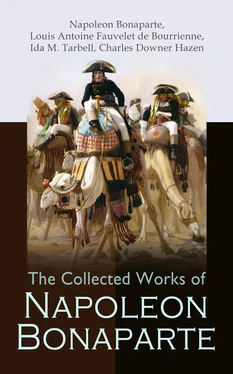Napoleon Bonaparte, Louis Antoine Fauvelet de Bourrienne, Ida M. Tarbell, Charles Downer Hazen
The Collected Works of Napoleon Bonaparte
Life & Legacy of the Great French Emperor: Biography, Memoirs & Personal Writings
e-artnow, 2021
Contact: info@e-artnow.org
EAN 4064066498764
The Works of Napoleon Bonaparte: The Works of Napoleon Bonaparte: Table of Contents
Maxims of War
Proclamations, Speeches, Diplomatic Correspondence & Personal Letters
Napoleon's Letters to Josephine
The Life & Legacy of Napoleon:
The History of Napoleonic Wars
The Biography of Napoleon Bonaparte
The Memoirs of Napoleon Bonaparte by Bourrienne
The Works of Napoleon Bonaparte:
Table of Contents
Table of Contents
MAXIM I.
MAXIM II.
MAXIM III.
MAXIM IV.
MAXIM V.
MAXIM VI.
MAXIM VII.
MAXIM VIII.
MAXIM IX.
MAXIM X.
MAXIM XI.
MAXIM XII.
MAXIM XIII.
MAXIM XIV.
MAXIM XV.
MAXIM XVI.
MAXIM XVII.
MAXIM XVIII.
MAXIM XIX.
MAXIM XX.
MAXIM XXI.
MAXIM XXII.
MAXIM XXIII.
MAXIM XXIV.
MAXIM XXV.
MAXIM XXVI.
MAXIM XXVII.
MAXIM XXVIII.
MAXIM XXIX.
MAXIM XXX.
MAXIM XXXI.
MAXIM XXXII.
MAXIM XXXIII.
MAXIM XXXIV.
MAXIM XXXV.
MAXIM XXXVI.
MAXIM XXXVII.
MAXIM XXXVIII.
MAXIM XXXIX.
MAXIM XL.
MAXIM XLI.
MAXIM XLII.
MAXIM XLIII.
MAXIM XLIV.
MAXIM XLV.
MAXIM XLVI.
MAXIM XLVII.
MAXIM XLVIII.
MAXIM XLIX.
MAXIM L.
MAXIM LI.
MAXIM LII.
MAXIM LIII.
MAXIM LIV.
MAXIM LV.
MAXIM LVI.
MAXIM LVII.
MAXIM LVIII.
MAXIM LIX.
MAXIM LX.
MAXIM LXI.
MAXIM LXII.
MAXIM LXIII.
MAXIM LXIV.
MAXIM LXV.
MAXIM LXVI.
MAXIM LXVII.
MAXIM LXVIII.
MAXIM LXIX.
MAXIM LXX.
MAXIM LXXI.
MAXIM LXXII.
MAXIM LXXIII.
MAXIM LXXIV.
MAXIM LXXV.
MAXIM LXXVI.
MAXIM LXXVII.
MAXIM LXXVIII.
Table of Contents
The frontiers of states are either large rivers, or chains of mountains, or deserts. Of all these obstacles to the march of an army, the most difficult to overcome is the desert; mountains come next, and broad rivers occupy the third place.
Napoleon, in his military career, appears to have been called upon to surmount every difficulty which can occur in wars of invasion.
In Egypt he traversed deserts, and vanquished and destroyed the Mamelukes, so celebrated for their address and courage. His genius knew how to accommodate itself to all the dangers of this distant enterprise, in a country ill adapted to supply the wants of his troops.
In the conquest of Italy, he twice crossed the Alps by the most difficult passes, and at a season, too, which rendered this undertaking still more formidable. In three months he passed the Pyrenees, defeated and dispersed four Spanish armies. In short, from the Rhine to the Borysthenes, no natural obstacle could be found to arrest the rapid march of his victorious army.
Table of Contents
In forming the plan of a campaign, it is requisite to foresee everything the enemy may do, and to be prepared with the necessary means to counteract it.
Plans of campaign may be modified ad infinitum according to circumstances—the genius of the general, the character of the troops, and the topography of the theatre of action.
Sometimes we see a hazardous campaign succeed, the plan of which is directly at variance with the principles of the art of war. But this success depends generally on the caprice of fortune, or upon faults committed by the enemy—two things upon which a general must never count. Sometimes the plan of a campaign, although based on sound principles of war, runs the risk of failing at the outset if opposed by an adversary who acts at first on the defensive, and then, suddenly seizing the initiative, surprises by the skilfulness of his manœuvres. Such was the fate of the plan laid down by the Aulic council for the campaign of 1796, under the command of Marshal Wurmser. From his great numerical superiority, the marshal had calculated on the entire destruction of the French army, by cutting off its retreat. He founded his operations on the defensive attitude of his adversary, who was posted on the line of the Adige, and had to cover the siege of Mantua, as well as central and lower Italy.
Wurmser, supposing the French army fixed in the neighborhood of Mantua, divided his forces into three corps, which marched separately, intending to unite at that place. Napoleon, having penetrated the design of the Austrian general, perceived the advantage to be derived from striking the first blow against an army divided into three corps, with no communication between them. He hastened, therefore, to raise the siege of Mantua, assembled the whole of his forces, and by this means became superior to the imperialists, whose divisions he attacked and beat in detail. Thus Wurmser, who fancied he had only to march to certain victory, saw himself compelled, after ten days campaign, to retire with the remains of his army into the Tyrol, after a loss of twenty-five thousand men in killed and wounded, fifteen thousand prisoners, nine stand of colors, and seventy pieces of cannon.
Hence, nothing is so difficult as to prescribe beforehand to a general the line of conduct he shall pursue during the course of a campaign. Success must often depend on circumstances that cannot be foreseen; and it should be remembered, likewise, that nothing cramps so much the efforts of genius as compelling the head of an army to be governed by any will but his own.
Table of Contents
An army which undertakes the conquest of a country, has its two wings resting either upon neutral territories, or upon great natural obstacles, such as rivers or chains of mountains. It happens in some cases that only one wing is so supported; and in others that both are exposed.
In the first instance cited, viz., where both wings are protected, a general has only to protect his front from being penetrated. In the second, where one wing only is supported, he should rest upon the supported wing. In the third, where both wings are exposed, he should depend upon a central formation, and never allow the different corps under his command to depart from this: for if it be difficult to contend with the disadvantage of having two flanks exposed, the inconvenience is doubled by having four , trebled if there be six —that is to say, if the army is divided into two or three different corps. In the first instance, then, as above quoted, the line of operation may rest indifferently on the right or on the left. In the second, it should be directed toward the wing in support. In the third, it should be perpendicular to the centre of the army’s line of march. But in all these cases it is necessary, at a distance of every five or six days march, to have a strong post or an entrenched position upon the line of operation, in order to collect military stores and provisions, to organize convoys, to form of it a centre of movement, and establish a point of defence to shorten the line of operation of the army.
These general principles in the art of war were entirely unknown, or lost sight of, in the middle ages. The crusaders in their incursions into Palestine appear to have had no object but to fight and to conquer, so little pains did they take to profit by their victories. Hence, innumerable armies perished in Syria, without any other advantage than that derived from the momentary success obtained by superior numbers.
Читать дальше












